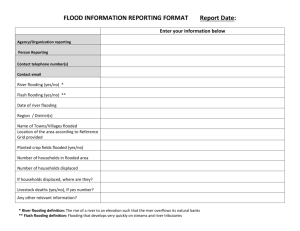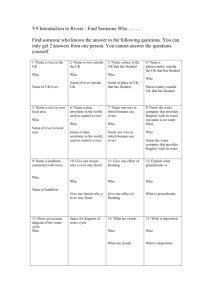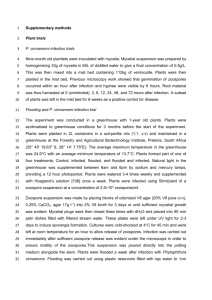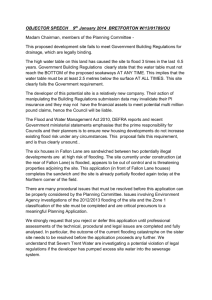Proceedings VII World Avocado Congress 2011 (Actas VII Congreso Mundial... Cairns, Australia. 5 – 9 September 2011
advertisement
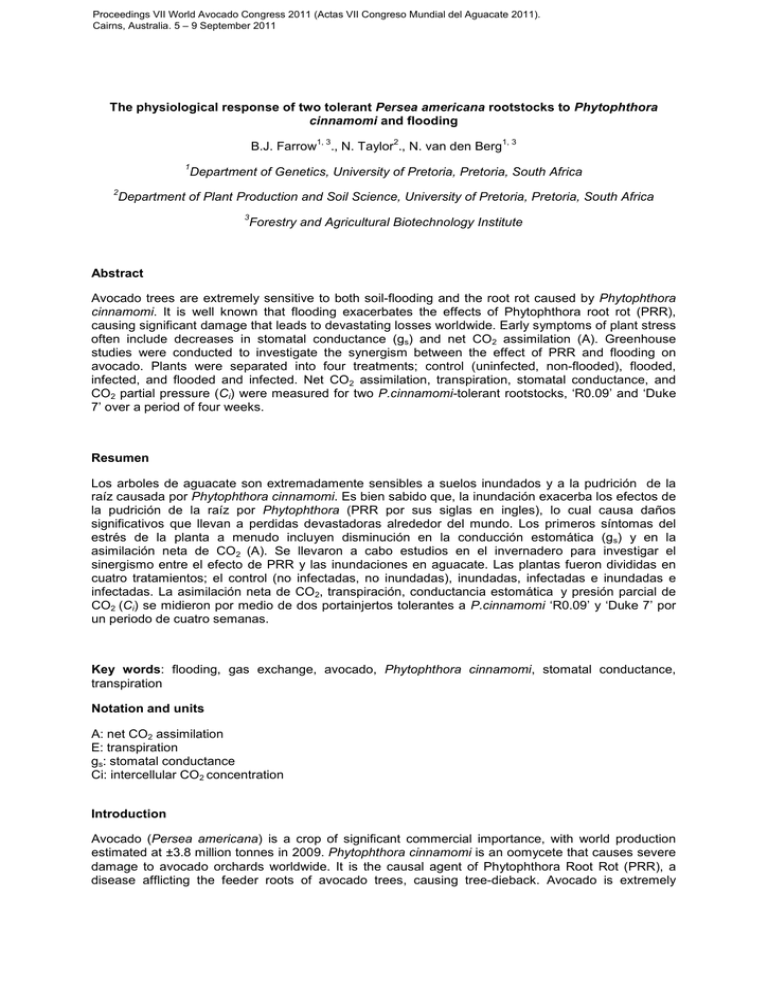
Proceedings VII World Avocado Congress 2011 (Actas VII Congreso Mundial del Aguacate 2011). Cairns, Australia. 5 – 9 September 2011 The physiological response of two tolerant Persea americana rootstocks to Phytophthora cinnamomi and flooding 1, 3 B.J. Farrow 2 ., N. Taylor ., N. van den Berg 1, 3 1 Department of Genetics, University of Pretoria, Pretoria, South Africa 2 Department of Plant Production and Soil Science, University of Pretoria, Pretoria, South Africa 3 Forestry and Agricultural Biotechnology Institute Abstract Avocado trees are extremely sensitive to both soil-flooding and the root rot caused by Phytophthora cinnamomi. It is well known that flooding exacerbates the effects of Phytophthora root rot (PRR), causing significant damage that leads to devastating losses worldwide. Early symptoms of plant stress often include decreases in stomatal conductance (gs) and net CO2 assimilation (A). Greenhouse studies were conducted to investigate the synergism between the effect of PRR and flooding on avocado. Plants were separated into four treatments; control (uninfected, non-flooded), flooded, infected, and flooded and infected. Net CO2 assimilation, transpiration, stomatal conductance, and CO2 partial pressure (Ci) were measured for two P.cinnamomi-tolerant rootstocks, ‘R0.09’ and ‘Duke 7’ over a period of four weeks. Resumen Los arboles de aguacate son extremadamente sensibles a suelos inundados y a la pudrición de la raíz causada por Phytophthora cinnamomi. Es bien sabido que, la inundación exacerba los efectos de la pudrición de la raíz por Phytophthora (PRR por sus siglas en ingles), lo cual causa daños significativos que llevan a perdidas devastadoras alrededor del mundo. Los primeros síntomas del estrés de la planta a menudo incluyen disminución en la conducción estomática (gs) y en la asimilación neta de CO2 (A). Se llevaron a cabo estudios en el invernadero para investigar el sinergismo entre el efecto de PRR y las inundaciones en aguacate. Las plantas fueron divididas en cuatro tratamientos; el control (no infectadas, no inundadas), inundadas, infectadas e inundadas e infectadas. La asimilación neta de CO2, transpiración, conductancia estomática y presión parcial de CO2 (Ci) se midieron por medio de dos portainjertos tolerantes a P.cinnamomi ‘R0.09’ y ‘Duke 7’ por un periodo de cuatro semanas. Key words: flooding, gas exchange, avocado, Phytophthora cinnamomi, stomatal conductance, transpiration Notation and units A: net CO2 assimilation E: transpiration gs: stomatal conductance Ci: intercellular CO2 concentration Introduction Avocado (Persea americana) is a crop of significant commercial importance, with world production estimated at ±3.8 million tonnes in 2009. Phytophthora cinnamomi is an oomycete that causes severe damage to avocado orchards worldwide. It is the causal agent of Phytophthora Root Rot (PRR), a disease afflicting the feeder roots of avocado trees, causing tree-dieback. Avocado is extremely sensitive to flooding (GIL et al. 2007; W AGER 1942) and it is well-known that soil-flooding exacerbates the damage caused by P.cinnamomi (PLOETZ and SCHAFFER 1987; W AGER 1942). Although many flood-tolerant plant species exist, the growth and development of many plants is adversely affected by soil flooding (DAVIES and FLORE 1986; OOSTERHUIS et al. 1990). Flooding is a complex stress, with factors such as plant species, period and timing of flooding, and conditions of flood water affecting the plant response to flooding (OOSTERHUIS et al. 1990). Flooding is often caused by high rainfall, high water tables, inadequate drainage, or poor irrigation management. The main factor causing damage in flooded soils is insufficient O2 for normal respiration (DREW 1997). This is caused by a significantly reduced rate of diffusion through water in comparison to air (GIL et al. 2007). Reductions in photosynthesis or net CO2 assimilation (A) and transpiration (E) occur under both biotic and abiotic stress conditions (FLEISCHMANN et al. 2002), and flooding affects both physiological and biochemical process including CO2 assimilation, stomatal conductance and enzyme efficiencies (DAVIES and FLORE 1986). Previous studies (PLOETZ and SCHAFFER 1989; PLOETZ and SCHAFFER 1987) have shown that reductions in net CO2 assimilation and stomatal conductance (gs) are early responses to infection by P.cinnamomi and flooding, and are thus useful physiological indicators to measure the host stress response under these conditions. Additionally, measurements of intercellular CO2 concentration (Ci) are useful in determining which factors are limiting photosynthesis under stress. Understanding the physiological mechanisms behind this response is important in order to understand the mechanisms involved in stress response and stress tolerance. The aim of this study was to observe the physiological response of two rootstocks tolerant to Phytophthora cinnamomi to infection by the pathogen in addition to flooding conditions and to relate these responses to rootstock tolerance. Leaf gas exchange, stomatal conductance and intercellular CO2 concentration were measured with an open-path portable photosynthesis system in order to determine the effects of infection and flooding on clonal avocado plants derived from two commercially available PRR tolerant rootstocks. Materials and methods Phytophthora cinnamomi isolates and infection P.cinnamomi isolates were obtained from Tzaneen, South Africa. Cultures were grown on V8 agar at 20°C. Zoospores were produced by cutting small blocks of the colonized V8 agar and placing them in 2% V8 broth for 3 days or until sufficient mycelial growth was visible. Mycelia were rinsed three times with distilled H2O, ensuring all broth was removed. Mycelia was then placed in 2x filtered stream H2O and left under UV light for 2-3 days or until sufficient sporangia formation was visible under a light microscope. Cultures were cold-shocked by placing @ 4°C for 45min. Cultures were then allowed to stand for an hour to allow release of zoospores. After release, infection was immediately carried out to ensure motility of zoospores. Infection was carried out using 50ml/plant of a zoospore suspension at a 4 concentration of 2.5×10 zoospores/ml. Infection was carried out 21 days after plants were replanted in order to minimize the stress response to replanting. Infection was confirmed by re-isolation of the pathogen and subsequent use of the P.cinnamomi specific LPV3 primers (KONG et al. 2003) in a polymerase chain reaction (PCR). Plant material The experiment was conducted with 1-year old clonal ‘R0.09’ and ‘Duke 7’ avocado plants. Plants were acclimatised to greenhouse conditions for 3 months before the start of the experiment. ‘R0.09’ and ‘Duke 7’, two commercially available, PRR-tolerant rootstocks were used. Plants were planted in 2L containers in a soil-perlite mix (1:1) and maintained in a greenhouse at the Forestry and Agricultural Biotechnology Institute, Pretoria, South Africa (25° 45' 19.63" S, 28° 14' 7.75"E). Plants from each rootstock formed part of one of four treatments; Control, infected, flooded, and flooded and infected. Natural light in the greenhouse was supplemented between 6am and 6pm by sodium and mercury lamps, providing a 12 hour photoperiod. Plants were watered 3-4 times weekly and supplemented with Hoagland’s solution once a week. Plants were flooded a week after infection with 2 P.cinnamomi. Flooding was carried out using plastic reservoirs filled with tap water to 1cm below the potting mixture. Gas exchange parameters Gas-exchange measurements were carried out using an open-path portable photosynthesis system (LI-6400XT, LI-COR, Lincoln, Nebraska-USA). Measurements of leaf CO2 assimilation (A), transpiration (E), stomatal conductance (gs), and intercellular CO2 concentration (Ci) were taken every third day. Humidity was held between 40-50% and leaf temperature was always between 23-28 °C. Gas exchange was generally measured using the third fully expanded leaf from the apex of each plant where possible, using a total of 10 replicates per treatment. Stomatal conductance and transpiration measurements were made on the same leaves as those made for photosynthesis. Photosynthetic -2 photon flux density levels were relatively low in the greenhouse, with maximum levels at 225 µmol m -1 s . Experimental design and statistical analysis The experiment was laid out in a completely randomized block, with four treatments and 10 plants per treatment. Statistical analysis was performed using JMP® (SAS, Cary, USA) version 9.0.0. Significance analysis was based on the student’s t-test. Results and discussion In this study clonal avocado plants were used to assess their tolerance to Phytophthora cinnamomi, flooding, and a combination of the two. Plant material consisted of two commercially available rootstocks, ‘R0.09’ or ‘Duke 7’. These rootstocks have been selected for use in industry as they have shown tolerance to P.cinnamomi . Several studies have shown that reductions in net CO2 assimilation, stomatal conductance and transpiration are seen when plants are exposed to stress, including flooding stress (DA SILVA et al. 2011; GIL et al. 2007; SCHAFFER and PLOETZ 1989). More specifically, previous studies looking at PRR and flooding suggest that reductions in net CO2 assimilation and stomatal conductance are some of the earliest responses to these conditions (PLOETZ and SCHAFFER 1989; PLOETZ and SCHAFFER 1987). Other studies have observed reductions in intercellular CO2 concentration under stress conditions (DA SILVA et al. 2011) which is probably related to the decline in stomatal conductance. Avocado is a flood-sensitive crop, and as such net CO2 assimilation is expected to be reduced as this is a typical characteristic of flood-sensitive plants (DIAS-FILHO and CARVALHO 2000b). Plants were infected a week before flooding was started so as to allow establishment of infection. Re-isolation and use of primers specific for Phytophthora cinnamomi confirmed that infection was successful and that control plants were free of P.cinnamomi. Net CO2 assimilation Rates of net CO2 assimilation of avocado trees infected with P.cinnamomi, flooded, and infected and flooded were compared to control plants and significant differences were found between treatments (Fig.1). Flooded treatments always showed reduced A values when compared to non-flooded treatments, with significant differences at several points. ‘R0.09’ is the rootstock more tolerant to PRR, and infected, non-flooded plants showed values similar to control plants. Generally flooded treatments exhibited lower photosynthetic rates than non-flooded treatments. Flooded, uninfected plants showed significant decreases when compared to control plants from day 22 after infection (15 days after the start of flooding) until day 29 when the trial was ended. Flooded plants that were also infected showed significant differences from control plants earlier on, with significant reductions apparent at day 19. ‘Duke 7’ showed similar results to ‘R0.09’, with flooded and flooded, infected plants showing significant differences from control plants from day 19 on. The non-flooded, infected ‘R0.09’ plants showed similar values to control plants over the entire study, demonstrating their tolerance to PRR. ‘Duke 7’ non-flooded, infected plants performed better than the flooded treatments, but A was still significantly reduced compared to control plants (Fig. 1B.). Net CO2 assimilation dropped noticeably 15 days after 3 infection as it was overcast and raining, leading to low light levels and thus low net CO2 assimilation rates. Interestingly neither ‘R0.09’ nor ‘Duke 7’ plants that were flooded and infected were able to recover, and A values remained low for the rest of the experiment. Fig. 1. Effects of Phytophthora cinnamomi and flooding on the net CO2 assimilation (A) of ‘R0.09’ (a) and ‘Duke 7’ (b) avocados grown in a soil-perlite potting medium. Plants were flooded 7 days after infecting with P.cinnamomi. The symbols:* (significantly different from infected and flooded), Δ(significantly different from infected), ‡(significantly different from flooded), ×(significantly different from control) indicate significant differences for mean assimilation values according to student’s t-test (P < 0.05). In ‘R0.09’, a rootstock tolerant to PRR, the infected, non-flooded plants responded in an almost identical manner to the control. ‘Duke 7’ infected, non-flooded plants had significantly lower values for A than control plants. The maintenance of photosynthesis in infected ‘R0.09’ plants as compared to ‘Duke 7,’ could be used as an important indicator of tolerance to PRR in avocado rootstocks. The reason behind the maintenance of photosynthetic rates in infected ‘R0.09’ plants remains to be elucidated. Stomatal conductance Stomatal conductance is known to decrease under abiotic stress such as drought and flooding (DIASFILHO and CARVALHO 2000b) (FARQUHAR and SHARKEY 1982). In the present study both rootstocks showed lower values for gs in flooded treatments when compared to non-flooded treatments (Fig. 2.). In ‘R0.09’, gs values for flooded, infected plants were significantly different from control plants and nonflooded, infected plants from 19 days post-infection, whereas differences in uninfected, flooded plants 4 only became significant around 26 days post-infection. This suggests that the flooded treatment performs slightly better when compared to the flooded, infected treatment. ‘R0.09’ non-flooded and control plants responded similarly throughout the study. ‘Duke 7’ flooded treatments showed significant reductions in gs values when compared to non-flooded treatments from days 19 postinfection. Additionally, non-flooded, infected plants had significantly higher gs values when compared to flooded treatments; however the gs values of these plants were significantly lower when compared to control plants. These results were consistent with the results obtained for net carbon assimilation (A) (Fig.1). Fig. 2. Effect of Phytophthora cinnamomi and flooding on the stomatal conductance (gs) of ‘R0.09’ (a) and ‘Duke 7’ (b) avocados grown in a soil-perlite potting medium. The symbols:* (significantly different from infected and flooded), Δ(significantly different from infected), ‡(significantly different from flooded), ×(significantly different from control) indicate significant differences for mean conductance values according to student’s t-test (P < 0.05). Schaffer and Ploetz (1989) found the relationship between the A and gs of flooded and non-flooded plants to be positive curvilinear, which is what was observed in this study (Fig.3.&4.). In previous work (PLOETZ and SCHAFFER 1989; PLOETZ and SCHAFFER 1987) A and gs were always greatly reduced when infected plants were flooded, but not reduced consistently when plants with root-rot were not flooded. This is consistent with our results (Fig.3.&4.). Other authors have also observed a close relationship between stomatal conductance and CO2 assimilation, and have suggested that net photosynthesis is primarily influenced by stomatal conductance under flooding conditions (DIAS-FILHO and CARVALHO 2000b). A relationship between A and gs is expected as the greater the stomatal conductance, the greater the photosynthesis and vice versa. In comparison to the other treatments, flooded, infected ‘R0.09’ plants have lower values for A at the same gs, suggesting that there are perhaps other factors limiting A in addition to stomatal conductance. The values obtained for intercellular Ci concentrations (Fig.4.) are in agreement with this theory. If we compare ‘R0.09’ with ‘Duke 7’ we see that at the same gs ‘R0.09’ is able to sustain higher A, possibly showing that ‘R0.09’ is able to protect photosynthetic machinery more efficiently than ‘Duke 7’. 5 Fig.3. Net CO2 assimilation (A) vs. stomatal conductance (gs) for ‘R0.09’ avocado plants grown in a soil-perlite mix (1:1). (a) Flooded, infected plants; (b) non-flooded, infected plants; (c) flooded plants; (d) control plants. Fig.4. Net CO2 assimilation (A) vs. stomatal conductance (gs) for ‘Duke 7’ avocado plants grown in a soil-perlite mix (1:1). (a) Flooded, infected plants; (b) non-flooded, infected plants; (c) flooded plants; (d) control plants. 6 Intercellular CO2 (Ci) Ci or intercellular CO2 concentration represents the amount of CO2 within the stomatal cavity of the leaf at a given time. In the present study flooded treatments generally had higher Ci values, with significant differences present for both rootstocks 26 days after infection (Fig. 4.). Infected, nonflooded plants did not have Ci values significantly different from control plants in either treatment. This suggests that an increase in Ci is more strongly influenced by flooding conditions than by infection with P.cinnamomi. For ‘R0.09’ plants the Ci values were the highest for the infected, flooded treatment. These values were significantly different from both the control plants and the infected, non-flooded plants from as early as 12 days post infection (5 days after flooding) and differences remained significant until the end of the experiment. Significant differences were also observed between the infected, flooded plants and the flooded plants from day 12 after infection until day 26 when differences were no longer significant. ‘Duke 7’ followed the same trend as ‘R0.09’; however differences only became significant near the end of the experiment. Determinations of the Ci are useful for in determining whether gs is limiting A or whether A is limited by some other factor in the early response to flooding. Ci should decrease if a drop in A is caused by a reduction in gs (FARQUHAR and SHARKEY 1982). An increase in Ci as gs decreases would imply that it is instead a decrease in A causing the reductions in gs. It can thus be determined whether a reduction in A or a reduction in gs is the earlier response to flooding and P.cinnamomi (SCHAFFER and PLOETZ 1989). Initial decreases in A may be caused by decreased gs, but the fact that there is a later increase of Ci in flooded plants implies that additional factors, such as biochemical limitations, are also contributing to the decrease in A. The increases in Ci are paralleled by decreased in gs (Fig.2.). This had been observed in various other studies (DA SILVA et al. 2011), including studies performed on blueberry (DAVIES and FLORE 1986) and soybean (OOSTERHUIS et al. 1990). Fig. 5. Effect of Phytophthora cinnamomi and flooding on the intercellular CO2 concentration (Ci) of ‘R0.09’ (a) and ‘Duke 7’ (b) avocados grown in a soil-perlite potting medium. The symbols:* (significantly different from infected and flooded), Δ(significantly different from infected), ‡(significantly different from flooded), ×(significantly different from control) indicate significant differences for mean conductance values according to student’s t-test (P < 0.05). Transpiration Reductions in transpiration occur alongside reductions in net CO2 assimilation under conditions of stress (FLEISCHMANN et al. 2002). These reductions in transpiration are thought to occur under flooding conditions when stomata close to reduce transpirational water loss and thus also result in decreased gs (GIL et al. 2007). In the present study transpiration rates were significantly lower in treatments that had been flooded than in non-flooded treatments (Fig. 5.). 7 Fig. 5. Effect of Phytophthora cinnamomi and flooding on the transpiration of ‘R0.09’ (a) and ‘Duke 7’ (b) avocados grown in a soil-perlite potting medium. The symbols:* (significantly different from infected and flooded), Δ(significantly different from infected), ‡(significantly different from flooded), ×(significantly different from control) indicate significant differences for mean conductance values according to student’s t-test (P < 0.05). Flooded and flooded, infected ‘R0.09’ plants showed significantly lower rates of transpiration than control plants and infected, non-flooded plants (Fig. 5a.), although flooding alone only showed significant differences 26 days after infection compared to 19 days after infection for flooded, infected plants. ‘Duke 7’ plants also showed lower transpiration rates for flooded and flooded, infected plants compared to infected and control plants (Fig. 5b). Differences between non-flooded, infected plants and control plants were significant for ‘Duke 7’, as opposed to ‘R0.09’ plants where non-flooded, infected plants responded similarly to control plants. Transpiration rates were still significantly higher in non-flooded, infected plants when compared to the flooded treatments. This suggests that while both ‘R0.09’ and ‘Duke 7’ are considered tolerant rootstocks, ‘R0.09’ performs significantly better than ‘Duke 7’. Flooding appears to have a much more significant effect on reducing the transpiration rate than infection alone. Conclusion Avocado is sensitive to flooding, showing reductions in net CO2 assimilation, stomatal conductance (gs) and transpiration (E). There appears to be synergism between infection by Phytophthora cinnamomi and flooding, with flooded, infected plants generally having lower A, gs, and E values than the other treatments. Flooded treatments were found to have higher values for intercellular CO2 concentrations (Ci), suggesting that early reductions in A may be due to stomatal limitations while later reductions are due to a combination of stomatal limitations and limitations within the biochemistry of the leaf. Under the conditions of the study, infected ‘R0.09’ plants were found to have higher values for A, gs and E than ‘Duke 7’ infected plants. This may imply that ‘R0.09’ is able to maintain photosynthesis more effectively than ‘Duke 7’ under stress conditions and may account for the increased tolerance to PRR seen in ‘R0.09’ when compared to ‘Duke 7’. Acknowledgements The authors would like to thank Westfalia Technological Services for the plant material used. Thanks also to the Department of Plant Production and Soil Science for use of their equipment. This work was supported financially by the Hans-Merensky foundation and the THRIP fund through the Department of Science and Technology, South Africa. 8 References SILVA, E. N., R. V. RIBEIRO, S. L. FERREIRA-SILVA, R. A. VIÉGAS and J. A. G. SILVEIRA, 2011 Salt stress induced damages on the photosynthesis of physic nut young plants. Scientia Agricola 68: 62-68. DAVIES, F. S., and J. A. FLORE, 1986 Short-term flooding effects on gas exchange and quantum yield of rabbiteye blueberry (Vaccinium ashei Reade). Plant physiology 81: 289. DIAS-FILHO, M. B., and C. J. R. D. E. CARVALHO, 2000b Physiological and morphological responses of Brachiaria spp. to flooding. Pesquisa Agropecuária Brasileira 35: 19591966. DREW , M. C., 1997 Oxygen deficiency and root metabolism: injury and acclimation under hypoxia and anoxia. Annual Review of Plant Biology 48: 223-250. FARQUHAR, G. D., and T. D. SHARKEY, 1982 Stomatal conductance and photosynthesis. Annual Review of Plant Physiology 33: 317-345. FLEISCHMANN, F., D. SCHNEIDER, R. MATYSSEK and W. O WALD, 2002 Investigations on net CO2 assimilation, transpiration and root growth of Fagus sylvatica infested with four different Phytophthora species. Plant Biology 4: 144-152. GIL, P. M., B. SCHAFFER, S. M. GUTIÉRREZ and C. LI, 2007 Effect of waterlogging on plant water status, leaf gas exchange and biomass of avocado. KONG, P., C. HONG and P. RICHARDSON, 2003 Rapid detection of Phytophthora cinnamomi using PCR with primers derived from the Lpv putative storage protein genes. Plant pathology 52: 681-693. OOSTERHUIS, D., H. SCOTT, R. HAMPTON and S. W ULLSCHLEGER, 1990 Physiological responses of two soybean [Glycine max (L.) Merr] cultivars to short-term flooding. Environmental and Experimental Botany 30: 85-92. PLOETZ, R., and B. SCHAFFER, 1989 Effects of flooding and Phytophthora root rot on net gas exchange and growth of avocado. Phytopathology 79: 204-208. PLOETZ, R. C., and B. SCHAFFER, 1987 Effects of flooding and Phytophthora root rot on photosynthetic characteristics of avocado, pp. 290-294. SCHAFFER, B., and R. C. PLOETZ, 1989 Net gas exchange as damage indicator for Phytophthora root rot of flooded and non-flooded avocado. HortScience 24: 653-655. WAGER, V. A., 1942 Phytophthora cinnamomi and wet soil in relation to the dying-back of avocado trees. Hilgardia 14: 517-532. DA 9
